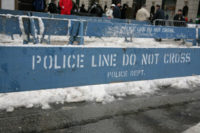5 Factors for Creating a Hardened Vehicular Perimeter Security System

Most everyone understands keeping military bases, embassies, courts, nuclear plants and other hard targets safe from terrorists. However, today, we must also keep retail shoppers safe, shield structures from accidental or intentional automobile crashes, protect hotel patrons from suicide car bombers, and keep employees and visitors from vehicle-based harm. From pedestrian-filled farmers markets and universities to new and used car lots, a wide variety of organizations find peace of mind through the use of barriers, bollards, barricades and crash gates for vehicle-based physical access control at the perimeter.
For those areas where a vehicle will never enter, fixed bollards and barriers are the norm. However, at entrances, barriers that go up and down are needed to let authorized vehicles through.
1. Risk Assessment Starts With Physics 101
A vehicle moving towards a barricade has kinetic energy, the major measure of how much "hitting power" it possesses. Mathematically, kinetic energy is derived from the vehicle velocity and its weight (mass). On impact, some of this energy is converted to heat, sound and permanent deformation of the vehicle. The barricade must absorb the remainder of this energy if the vehicle is to be stopped.
The amount of remaining energy depends on many factors, primarily the velocity of the vehicle at the moment of impact. The amount of kinetic energy posed by a vehicle changes as the square of its velocity. For example, a vehicle moving at 50 mph (80 kph) has 25 times as much kinetic energy as it would at 10 mph (16 kph). Thus, an armored car weighing 30 times as much as a Toyota Corolla and moving at 10 mph (16kph) would have less hitting power than the Toyota moving at 60 mph (96 kph)!
2. Overcoming Common Design Deficiencies
Because of the relationship of velocity to the total kinetic energy possessed by the vehicle, every effort must be made by the security engineer to force a vehicle to slow down before it reaches the barricade. Straight lines make for faster and easier approaches for vehicles, so it's best to create curves on access roads to the facility as a natural impediment.
The most frequently used technique is to require a sharp turn immediately in front of the barrier. When vehicle speed is reduced by 50 percent, the "hitting power" is reduced by four times. If the speed is reduced by 2/3rds, the force of impact will be reduced by nine times.
3. Beware of Non-certified Equipment
Certified equipment has been tested and proven to work under extreme conditions, giving planners the confidence they can rely upon. Testing is normally by an independent testing company or government agency, such as the U.S. Department of State (DOS) and military. Comprehensive reports of test results are issued and are available from the testing agency or manufacturer.
4. Choose from Variety of Barriers and Bollards to Meet Any Circumstance
Barriers and bollards are capable of stopping and destroying a truck weighing up to 65,000 pounds and traveling at 50 mph. Such barricades can be raised or lowered at will to stop traffic or let it through. In an emergency, the thick steel plates or bollards pop out of the ground within 1.5 seconds.
At the other extreme, a mobile barrier can be light enough to be towed by a golf cart and set up in only 10 minutes. Nonetheless, it will stop a 5,000-pound vehicle going 50 mph.
5. Putting Vehicular Threat Tactics on the Defensive
By their very nature, terrorist attacks are unpredictable and predicated on surprise. Staying one step ahead by identifying vulnerable areas, and securing them, is critical to staving off vehicular attacks.
That means being able to deploy security equipment in tough conditions, at a moment's notice. As alluded to earlier, such equipment now exists in the form of portable, towable, temporary barriers. These barriers can be deployed quickly and effectively.
Terrorists typically don't go where they see barricades, so placing them wherever possible attacks can happen reduces security risks dramatically. Temporary barriers can protect facilities while permanent ones are being built and they're even effective for the long-term where physical conditions preclude permanent solutions.
No Application Too Large or Small
Protecting perimeters of soft target facilities is no small responsibility. Knowing you've got the right equipment in place to secure the facility and to prevent human tragedy brings a peace of mind that no amount of money can buy. Carefully researching available options and consulting with experts will ultimately lead to the right solution.
Looking for a reprint of this article?
From high-res PDFs to custom plaques, order your copy today!








